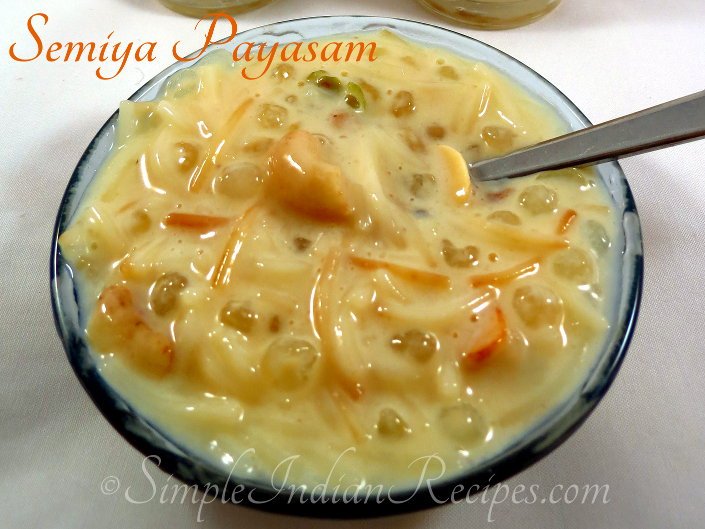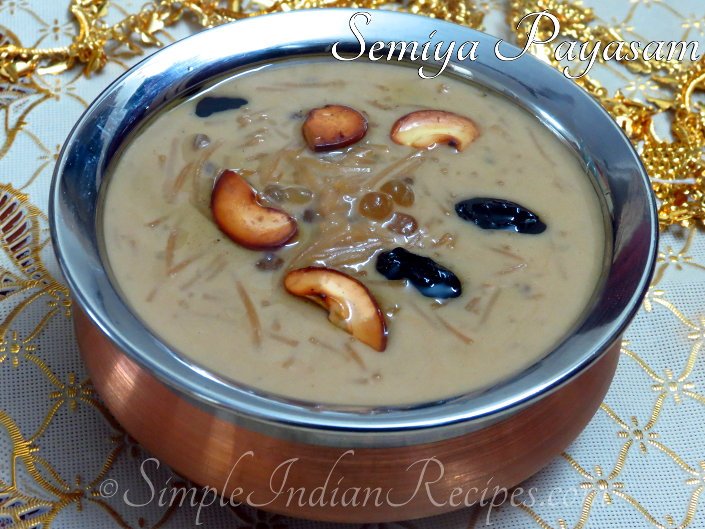- Submitted by Dahlia
(Pal Payasam, Seviyan Kheer, Vermicelli Pudding, White Payasam)

Payasam (or kheer) is a must have in all special occasions and festivals. Whether it is for marriages, Christmas, Onam, Diwali or any other festivals, payasam is surely there. There are many varieties of payasam made these days using different ingredients. I have also shared many in my website. The simplest as well as traditional one of them all is the semiya payasam, also known as the seviyan kheer. It is made with vermicelli pasta that is sold as sticks or in broken form. You get a thicker version of vermicelli and a thin one. You could use either one. You can also make the same payasam using other pasta varieties like angel hair, macroni etc. The vermicelli pasta cooks in the milk making it creamy and thick. It is also called paal payasam or vella payasam due to its white color by cooking in milk. This is the way the traditional semiya payasam is made and enjoyed by most.
I would also like to share a variation of this payasam that is probably made by very few. As we all know, payasams in South India are mainly of two categories: the one cooked in milk and sweetened with sugar( white payasam) and the one cooked in coconut milk and sweetened with jaggery (brown payasam). Payasam lovers mostly fall into the first category or the second. I am a person who loves the brown payasam. You must have seen that most of the payasams in the site are brown. So obviously, I also make a brown version of this semiya payasam. I have shown that below. Those who are allergic to milk or who do not like the taste of milk can try this version. It tastes awesome too.
So here is the recipe of semiya payasam with all the possible variations. Enjoy!
Recipe for Semiya Payasam
Preparation time: 10 minutes
Cooking time: 20 minutes
Serves: 4-6
Ingredients
- Semiya (Vermicelli Pasta) – ½ cup
- Sago (Sabudhana or javarisi) – 2 tbsp (optional)
- Milk – ½ liter (about 2.5 cups)
- Sugar – ½ cup
- Ghee – 2 tbsp
- Cardamom Powder – ¼ tsp
- Salt – a pinch
- Cashew nuts – 10
- Raisins – 2 tbsp
Method
- Soak the sago in some water for about 15 minutes while you get the other things ready. Sago is not necessarily added to the semiya payasam. I add it because my son loves it. Soaking the sago helps it to cook faster.
- Heat 1 tbsp of ghee in a pan. Roast the cashews and raisins for about 20 seconds until it turns golden brown.
- Remove it using a slotted spoon and keep it for adding later.
- In the same pan, add another tbsp. of ghee and roast the vermicelli on low flame. Keep stirring constantly until it turns golden brown. Do this carefully so that the vermicelli doesn’t get burnt.
- In the meantime, heat the milk in another burner.
- Once the semiya is roasted, add it to the milk. Also add the soaked sago.
- Cook for about 10 minutes on medium low flame with continuous stirring. Some people cook the semiya in water and then add the milk but cooking the semiya directly in the milk induces the flavor of semiya in the milk. Also, the vermicelli will not get overcooked and the nutty texture is perfectly retained.
- After the semiya and sago are cooked soft, add the sugar to the milk.
- Simmer for another 5 minutes and the payasam will be thickened. The payasam will continue to get thicker as it sits, keep that in mind and adjust the consistency with additional milk. Always keep additional milk handy when making this payasam. Some people like to eat the payasam with a spoon while others like to drink like a kheer. The above measurement makes a fairly thick payasam so add more milk if needed.
- Finally add the cardamom powder and the fried cashew nuts and raisins. Switch off and enjoy.

Serving Semiya Payasam
- Typically payasam is served hot but some people also like to eat it chilled.
- When reheating payasam, add some milk or water to bring it to the right consistency.
- In our native place, semiya payasam is served with sweet boondhi or with sweet boli.
Variation
- If you are making this for some special occasions and want a richer payasam, add a couple tbsp. of condensed milk to the payasam when adding the sugar.
- You can also add some saffron strands and other nuts like chopped almonds and pistachios.
- Adding sago is optional. You can also make sago payasam with just ½ cup of sago. That will be a separate post for later.
- As mentioned earlier, I also make the version of semiya payasam using jaggery and coconut milk. This brown semiya payasam will be great for people with milk allergy. Instead of regular dairy milk, cook the semiya in coconut milk. Substitute sugar with an equal quantity of jaggery. For that, melt the jaggery in ½ cup of water, strain it and add to the payasam.

More Payasam Recipes